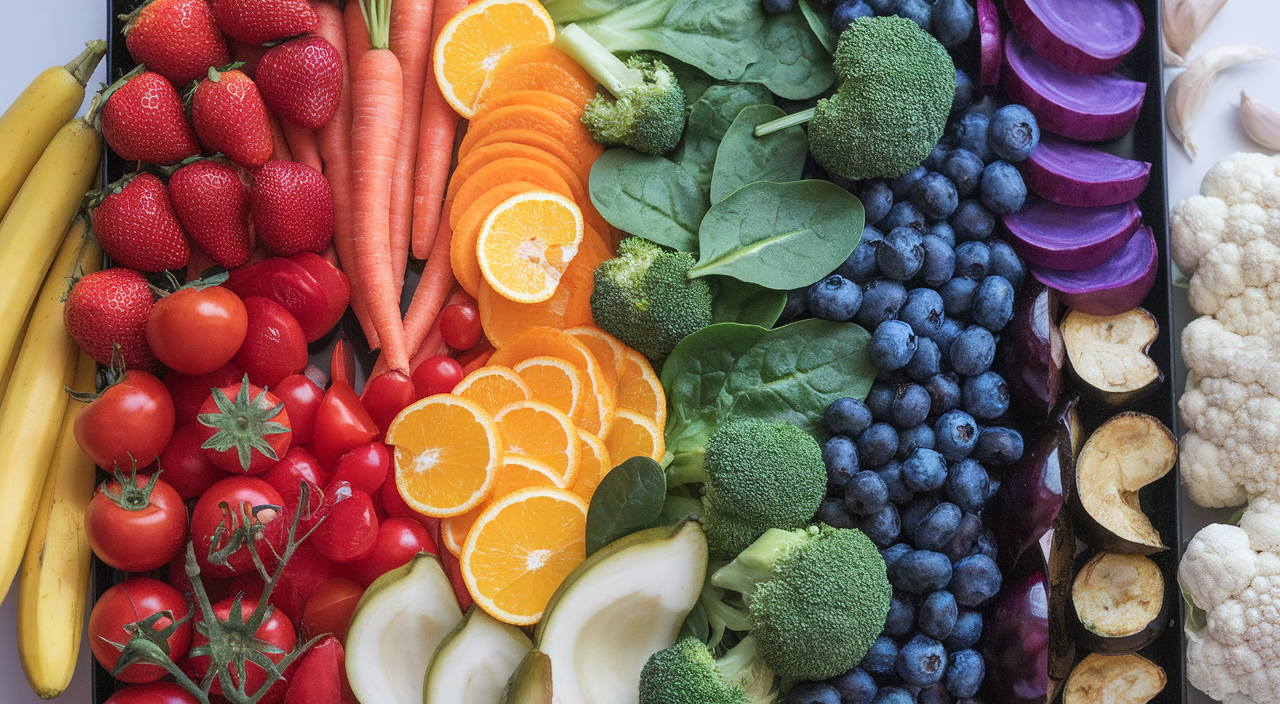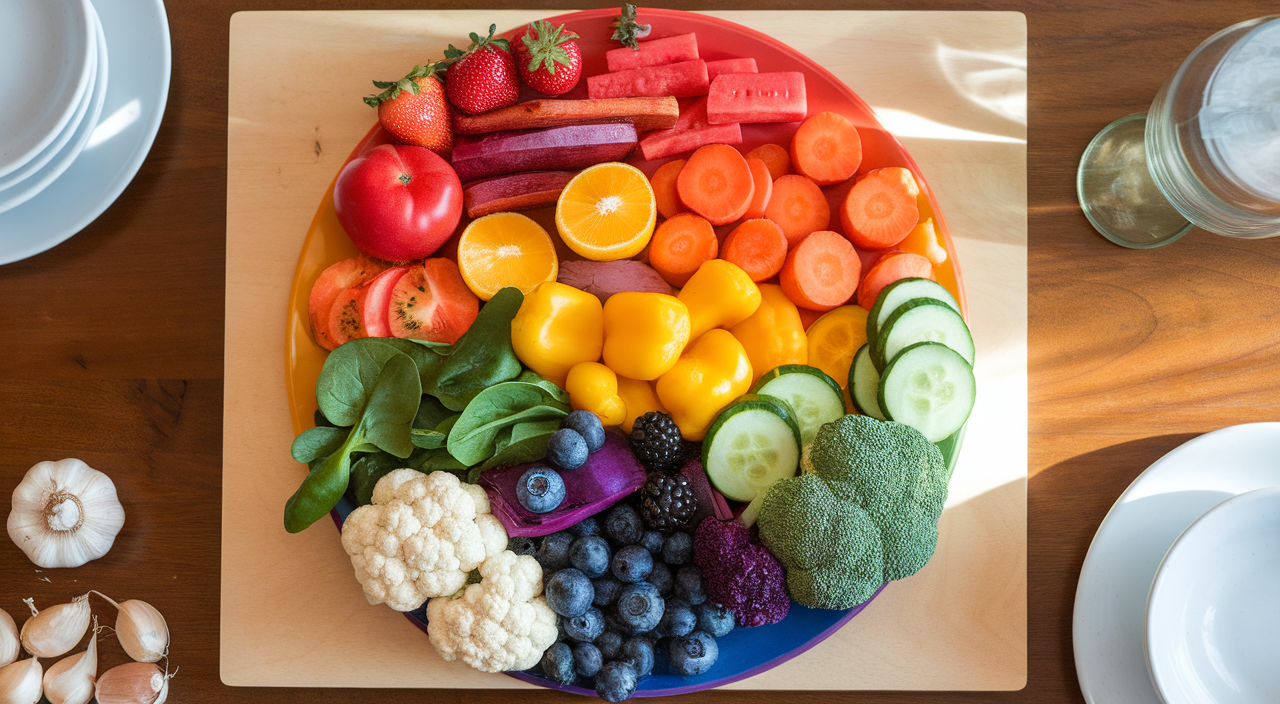I’ve turned eating healthy into an exciting game with the rainbow plate challenge. By adding different colored foods to my meals, I get maximum nutritional benefits while making my plates visually appealing.
Research backs this colorful approach—eating 800g of varied fruits and vegetables daily cuts heart disease and stroke risk by 24-33% and reduces early death rates by 31%. This simple strategy tackles a serious issue: only 12.3% of American adults eat enough fruits, and a mere 10% consume sufficient vegetables.
Key Takeaways
- Each color delivers unique health benefits: Red foods (like tomatoes) contain lycopene for heart health, orange/yellow foods provide vitamin C and beta-carotene, greens offer chlorophyll and folate, purple/blue foods have brain-boosting anthocyanins, and white foods supply immune-supporting allicin.
- Consuming a rainbow of foods provides a full spectrum of disease-fighting compounds that combat inflammation and boost immune function, protecting against conditions like type 2 diabetes and certain cancers.
- Including at least three different colored foods in each meal makes the challenge both enjoyable and nutritionally beneficial while helping meet the CDC’s recommended 1.5–2 cups of fruits and 2–3 cups of vegetables daily.
- The visual nature of the rainbow plate challenge makes nutritional tracking more straightforward than counting specific vitamins or minerals.
- Rotating through different options within each color category maximizes nutrient intake across various food sources while keeping meals interesting.
The Essential Health Benefits of Eating Every Color
Health Impact of the Rainbow Plate Challenge
I’ve seen remarkable health transformations when people embrace the rainbow plate challenge in their daily meals. Research shows that eating 800g of fruits and vegetables daily can slash your risk of heart disease and stroke by 24-33%. That’s about 10 portions of colorful produce—the amount linked to a 31% drop in premature mortality.
The Power of Color-Coded Nutrients
The rainbow plate challenge isn’t just about making your meals Instagram-worthy—each color packs unique health benefits. Here’s what different colored foods bring to your plate:
- Red (tomatoes, strawberries): Rich in lycopene for heart health
- Orange/Yellow (carrots, citrus): Packed with vitamin C and beta-carotene
- Green (spinach, broccoli): Loaded with chlorophyll and folate
- Purple/Blue (blueberries, eggplant): High in brain-boosting anthocyanins
- White (cauliflower, garlic): Contains immune-supporting allicin
I’ve found that focusing on eating these vibrant foods does more than just satisfy hunger—they’re packed with phytonutrients that act as powerful antioxidants. These compounds fight inflammation and boost immune function, providing solid protection against serious health conditions like type 2 diabetes and certain cancers.
Creating an attractive breakfast spread with colorful fruits and vegetables isn’t just visually appealing—it’s a simple way to kickstart your rainbow plate challenge each morning. By incorporating different colored foods throughout your day, you’re essentially giving your body a full spectrum of disease-fighting compounds.
Think of the rainbow plate challenge as your daily defense system. When you consistently fill your plate with varied colors, you’re not just eating—you’re actively supporting your long-term health. The key is making this colorful eating pattern a regular habit rather than a temporary fix.
Mastering the Rainbow Plate Challenge with Color-Based Nutrition
Red and Orange Foods Pack a Powerful Punch
I’ve found that starting the rainbow plate challenge with vibrant reds and oranges creates an exciting foundation. Red foods like tomatoes pack a serious antioxidant punch, delivering 3-4mg of lycopene per 100g. These red champions work alongside orange powerhouses like fresh oranges, which offer an impressive 53mg of immune-boosting vitamin C per 100g.
Here’s what you’ll want to include for these color groups:
- Tomatoes, watermelon, and strawberries for lycopene and anthocyanins
- Oranges, carrots, and sweet potatoes for beta-carotene
- Red bell peppers and grapefruit for a perfect color combo
Going Green to Purple: Your Rainbow Plate Challenge Essentials
The middle of the rainbow plate challenge focuses on nutrient-dense greens and blues. Dark leafy greens like spinach are particularly notable, containing 194mcg of folate per 100g – perfect for cell repair and growth. When creating an aesthetic breakfast tray, I always include a mix of these colorful options.
The blue and purple section brings in powerful antioxidants through:
- Fresh blueberries and blackberries for brain health
- Purple cabbage for gut-friendly fiber
- Purple cauliflower for extra visual appeal
Don’t forget about white and tan foods – they’re crucial players in your rainbow eating plan. Garlic and onions contain allicin, a compound that supports heart health. Cauliflower adds a neutral base while delivering important nutrients.
Each color group brings its own set of protective phytonutrients to your plate. I’ve learned that mixing these colors not only makes meals more appealing but also ensures I’m getting a full spectrum of nutrients. The key is to include at least three different colors in each meal – this makes the rainbow plate challenge both fun and beneficial.
Remember to rotate through different options within each color category. For example, if you’ve had tomatoes for your red portion today, try strawberries tomorrow. This variety keeps meals interesting and maximizes your nutrient intake across different food sources.
Why Most Americans Need This Challenge
The Rainbow Plate Challenge Addresses a Critical Health Gap
The statistics paint a concerning picture of American eating habits. According to CDC data, a mere 12.3% of adults in the United States hit their daily fruit intake targets, while an even smaller 10% reach the recommended vegetable servings. These numbers show why the rainbow plate challenge has become such a vital tool for improving nutrition.
I’ve found that making healthy eating fun and approachable through color-based goals helps more people stick to better habits. The rainbow plate challenge transforms what might feel like strict dietary rules into an engaging daily adventure of filling your plate with nature’s colors.
Benefits of Color-Based Eating Goals
When you join the rainbow plate challenge, you’re not just making your meals look prettier — you’re actively fighting nutritional gaps that affect most Americans. Each color in your rainbow plate challenge represents different nutrients your body needs:
- Red foods (like tomatoes and peppers) pack in lycopene
- Orange and yellow options boost beta-carotene levels
- Green vegetables provide essential folate and iron
- Purple produce delivers powerful antioxidants
- White foods offer immune-supporting compounds
I’ve seen how this color-focused approach makes nutritional tracking more straightforward than counting specific vitamins or minerals. Instead of getting caught up in complex nutritional charts, you can focus on creating beautiful breakfast arrangements and meals that naturally include a wide range of nutrients.
The rainbow plate challenge helps bridge the gap between current eating patterns and recommended intake levels. By aiming to include at least five different colored foods daily, you’re automatically increasing your chances of meeting those CDC-recommended 1.5–2 cups of fruits and 2–3 cups of vegetables. Plus, the visual nature of this challenge makes it easier to spot which colors (and therefore nutrients) might be missing from your diet.
Following this color-based eating pattern doesn’t just help with meeting nutritional guidelines — it makes healthy eating more exciting. When I look for purple potatoes or yellow bell peppers at the grocery store, it feels more like a treasure hunt than a chore. This mindset shift is exactly what many Americans need to transform their relationship with healthy foods.
Encouraging kids to eat a variety of colorful fruits and vegetables can be fun with ideas from the healthy eating activities shared by nutrition experts.
Sources:
Centers for Disease Control and Prevention – “Fruit and Vegetable Consumption”
International Journal of Epidemiology – “Fruit and vegetable intake and mortality”
Harvard T.H. Chan School of Public Health – “Vegetables and Fruits”
Academy of Nutrition and Dietetics – “Eat Right with Color”
Linus Pauling Institute, Oregon State University – “Phytochemicals”









